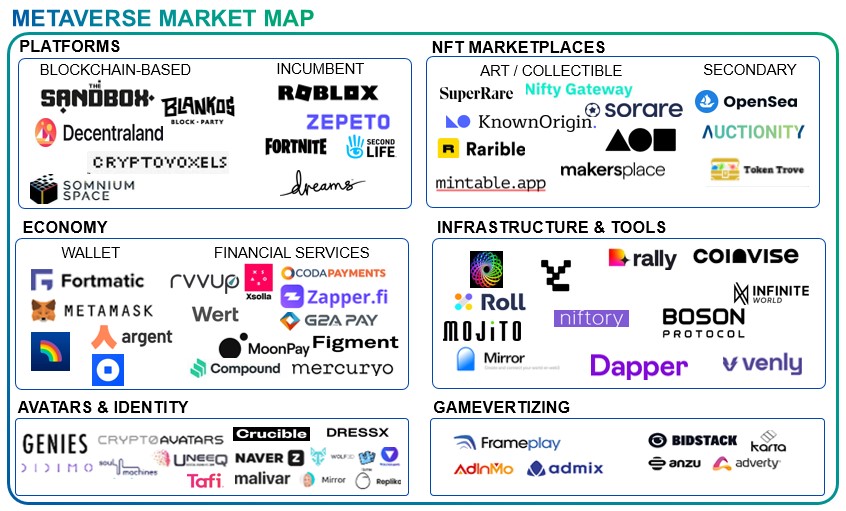“Brand” New World: How the Metaverse is Revolutionizing Customer Engagement

You’re sitting in the front row during New York Fashion Week, Anna Wintour to your right and Lady Gaga to your left. On the runway, models and influencers showcase the latest looks. A sparkly dress catches your eye, and in a matter of seconds you try it on and buy it.
This may sound like a fantasy, but in fact it is already a reality—in the Metaverse, at least.
As we have discussed in prior articles, the Metaverse is fast emerging as a new space where people can shop, be entertained, and participate in experiences that blur the lines between physical and digital life. Though the fashion industry has been an early adopter of Metaverse technology—for example, metaverse platform Decentraland recently hosted the first-ever Metaverse Fashion Week—this nascent virtual world already contains everything from music clubs to virtual home goods stores.
As an increasing number of consumers, particularly among Generations Z and Alpha, flock to the Metaverse, major tech industry players from Meta to Microsoft are investing billions of dollars into making it an indispensable part of everyday life. Assuming they are successful, brands of all sorts will need to reimagine their customer engagement models in order to delight people within this space. This will require new ways of communicating and marketing, and will present new revenue streams and opportunities for both brands and the companies that support them.
Meeting Customers in the Metaverse
The ascension of the mobile web and social media in the 2010s had a transformative impact on the ways brands engage with consumers. Having long advertised their wares in a linear, one-way manner—with little to no customer feedback or insights drawn from consumer behavior—brands were suddenly able to build community and use those insights to market and sell their products through influencers, hashtags, and viral Twitter feeds.
As the Metaverse gives rise to a new ecosystem of virtual life, a similarly consequential shift is now underway. Online games and digital spaces from Fortnite to Second Life are commanding increasing time, attention, and wallet-share from consumers, while the building blocks of the Metaverse (blockchain technology, cryptocurrencies, NFTs, etc.) are enabling people around the world to interact and collaborate in brand-new ways.
To adapt to this new reality and truly connect with customers in the Metaverse, therefore, brands will need to carefully reconsider many aspects of their marketing and sales strategies. This could include:
- Omnichannel Retail Experiences: The Metaverse is merging offline and online experiences in never-before-seen ways, empowering the next evolution in omnichannel retail. Brands such as Ralph Lauren and Gucci are experimenting with “direct-to-avatar” business models to sell digital fashion, art, and collectibles to people’s online personas, while Unreal Engine’s “MetaHuman Creator” could one day allow consumers to see a digital twin of themselves try on clothes then buy both a physical and virtual version for themselves and their twin. In this way, the Metaverse can help brands create truly frictionless shopping experiences and reach customers where they—and their avatars—are.
- “Gamevertising”: The global gaming market hit record highs during the pandemic and could reach $300 billion by 2025—three times larger than the global film industry at its peak in 2019. That has made gaming a key new playground for brands to connect with an engaged audience and advertise to them in a more personalized, experiential way. For example, fashion brand Balenciaga launched its Fall 2021 collection as a video game and is now collaborating with Metaverse game Fortnite on a marketing campaign that appears on billboards both in the game and in real-world cities like New York and Tokyo.
- Creativity and Interactivity: The Metaverse allows for “experiences that are unrepeatable in real life,” from nearly 28 million people attending five Travis Scott concerts in Fortnite to Nike building a space in the game Roblox where visitors from around the world can play virtual sports together. This empowers—perhaps even compels—brands to think outside the box and find unique ways to bring their audiences into the Metaverse experience they wish to curate, particularly through virtual reality (VR) and augmented reality (AR) technology.
- Values and Impact: In the 2020s, customers increasingly expect the companies and brands they do business with to reflect the identities and values that are important to them—especially younger people, who also happen to be the ones spending the most time in the Metaverse. Those customers will bring that same sensibility with them to the virtual realm, which means that brands will need to think beyond entertainment and consider how they can create inclusive, ethical Metaverse experiences as well.
Put simply, in the Metaverse brands will have an opportunity to co-create entire new worlds with their customers, not just sell to them. The possibilities are nearly limitless, but for most brands it will take some work to make them a reality.
How to Make it in the Metaverse
As the Metaverse hits the mainstream, global brands are beginning to invest in new digital marketing strategies to engage with customers there.
For some, that process may start with hiring a Chief Metaverse Officer (CMVO). Disney was one of the first major brands to do so, naming Disney Parks executive Mike White to the role earlier this year and tasking him with “connecting the physical and digital worlds” for its wide array of entertainment properties and products. Though there are currently only a handful of CMVOs in the world, many more could soon be on their way.
With or without a CMVO, brands looking to engage customers in the Metaverse will need to build knowledge and acquire tools and capabilities in its core technologies, from VR/AR and 5G internet to blockchain, crypto, and NFTs. With that knowledge in hand, they can then look to create and inhabit Metaverse spaces—a task that is easier said than done. Fortunately, a new ecosystem of startups is sprouting up to help brands do just that.
Brands that wish to create their own Metaverses can do so by leveraging end-to-end “metaverse-as-a-service” infrastructure and tools offered by startups like Clipo Labs. Those that would rather play within existing Metaverses such as The Sandbox can buy plots of virtual land and build virtual storefronts, then can work with companies like InfiniteWorld to create branded, gamified customer experiences. Finally, brands seeking to combine physical and digital goods omnichannel-style can partner with Boson Protocol to plug a Shopify-like e-commerce system into their virtual space, enabling them to sell physical products in the metaverse as NFTs.
This emerging commercial sector will need various financial products as well, from Metaverse-enabled digital wallets to mortgages to buy virtual land. With the decentralized finance (DeFi) space already thriving, the options abound and will only continue to increase.

Source: Citi Ventures
Opportunities for Financial Services
Though the full potential of the Metaverse is far from being realized, it presents numerous opportunities for financial services firms—opportunities that will evolve and increase as its enabling technologies mature and grow more widespread. These could include: financing virtual land purchases; providing payment services for companies that open virtual stores; and embedding products and services across the entire spectrum of Metaverse commerce. Citi Ventures is exploring investments in the space as well through our Future of Commerce vertical.
As consumer brands and financial institutions alike look to the future, it will be vital for them to be able to serve their customers wherever they are—and that includes the Metaverse.
For more of Citi Ventures’ thought leadership, investments, and efforts in the Metaverse space, click here.
